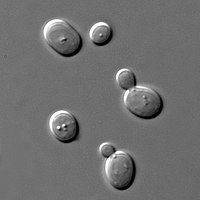
Photo from wikipedia
Abstract Due to the amount of yeast residues generated by the industries and their high capacity as biosorbent, this work proposes the use of yeast biomass in natura (YB) or… Click to show full abstract
Abstract Due to the amount of yeast residues generated by the industries and their high capacity as biosorbent, this work proposes the use of yeast biomass in natura (YB) or modified with ferromagnetic nanoparticles (Fe3O4) (YB-MNP) for Cu(II) removal from water. Synthesized YB-MNP, YB, and magnetite alone (MNP) were characterized by FTIR, XRD, and SEM. It was observed the efficient impregnation of magnetite on the surface of the biomass. Copper sorption was evaluated in batch tests using 100 mg/L of Cu(II) solution at pH 5.5, and the supernatant was analyzed by FAAS for Cu determination. Langmuir, Freundlich, and Dubinin–Radushkevich (D–R) isotherm models were applied to fit the experimental data. A favorable sorption process was observed for all the materials, mainly for the D–R model adjusted to the bionanocomposite data (YB-MNP), with r2 = 0.9950 and a low error (χ2 = 0.0427) associated to the model. Theoretical and experimentally Cu(II) sorption capacities were fairly similar, 8.6 ± 0.1 and 8.3 ± 0.2 mg/g, respectively.
Journal Title: Chemical Engineering Communications
Year Published: 2019
Link to full text (if available)
Share on Social Media: Sign Up to like & get
recommendations!